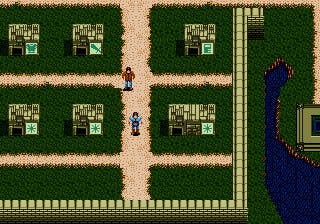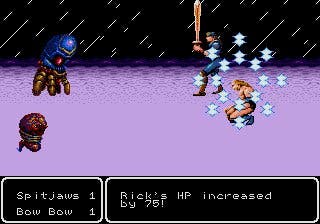Rising from the Grave
The story behind this year's new Mega Drive game.
"I had never played the Japanese version before," says Cobb, "but had remembered seeing the old Star Odyssey magazine ads when I was a kid. I thought to myself that releasing the game would allow us to give a gift to gamers that had been promised almost twenty years ago - since it hadn't shipped then, we'd ship it now."
The first hurdle was to acquire the rights to the game from Starfish-SD, the company which snapped up the back catalogue of the original developers HOT·B when the company succumbed to bankruptcy in 1993. Surprisingly, this wasn't as difficult as it sounds. "The only point that concerned Starfish-SD was that we didn't have a formal licensing agreement with Sega," says Cobb. "Sega of Japan quickly cleared that up for us, stating that they would not stand in the way of our products so long as we did not print any of their trademarks on the packaging. Once they understood Sega's standpoint, Starfish-SD signed the agreement with us straightaway."
With that potential minefield successfully navigated, there followed the not-inconsiderable task of actually bringing the game up to scratch. "Starfish-SD had not retained any source code or work files, so we were on our own in regard to the reprogramming process," Cobb explains. The upshot of this was that Super Fighter Team was essentially permitted to tinker with the game in any way they saw fit. However, the raw materials they had to work with were somewhat less appealing.
"The English prototype of Star Odyssey that we had was distributed to several members of the press, back in the early '90s," Cobb reveals. "Even for an early review submission, it stunk. Key elements of the game were missing, such as the animated cut scenes that appear between chapters. This meant we had to manually import such elements from the original Japanese version. The prototype also crashed after several hours of uninterrupted gameplay. This problem was caused by a notorious bug that was difficult to isolate; I think it took us several weeks to properly repair the affected code. To me, it soon became obvious that the English prototype of Star Odyssey was in fact based on a prototype of the Japanese version. To make the prototype on par with the Japanese version required a lot of the code to be rewritten."

Then there was the challenge of giving the game a decent English language conversion. Although the prototype had been translated from the original Japanese way back in the early '90s, working with it was a painful process. "I had a difficult time playing through the first time, because the English script didn't make any sense," winces Cobb. "The original localisation team was obviously made up of purely Japanese employees, none of which seemed to have an acceptable understanding of the English language beyond 'mechanical translation' ability. I couldn't understand even the most obvious hints, and instead had to rely on heavy guesswork to figure everything out."
With the game translated and the code polished, the next thing to consider was the creation of the physical cartridges and packaging. One would assume that creating media for a system which has been officially dormant since the end of the 1990s is a tough proposition. "It wasn't so much sourcing components as it was sourcing people," Cobb divulges. "We had to find someone who understood and appreciated what we were trying to do; someone who would look at the printed circuit board production as more than just a job. When you start getting into extra details such as copy protection, you're going to see a drop in the number of factories who want to work with you. In China, they want to make things that are cheap and easy. Our products are neither."

No matter how jaded you might be about the notion of retro gaming, it would take a particularly cold-hearted individual to sneer at the fact that after two decades of obscurity, Star Odyssey is finally in the hands of dedicated Mega Drive owners the world over. Thus far, the feedback has been hugely encouraging. The original print run quickly sold out, forcing Super Fighter Team to produce more carts to satisfy demand. "Customers have praised the quality of the script and consistency of the plot," explains Cobb when questioned on Star Odyssey's critical reaction. "For me, that's a large compliment, as I personally provided the rewritten script."
Whichever way you look at it, Super Fighter Team's success in what can only be considered a thoroughly niche sector of the market is massively heartening for anyone who yearns to see their favourite system gain a new lease of life. Cobb insists that there's much more to come from his studio. "We grow, both as a company and as individuals, with each successive product. That growth has presented us with new partnerships and introduced us to new markets. Expansion is inevitable, and we welcome it with open arms - but our goal will always be the same: making dreams tangible." As anyone who looked longingly at that tormenting Star Odyssey print advertisement back in the early '90s will have to admit, that's mission accomplished.
Star Odyssey is out now and is available for order directly from Super Fighter Team.








